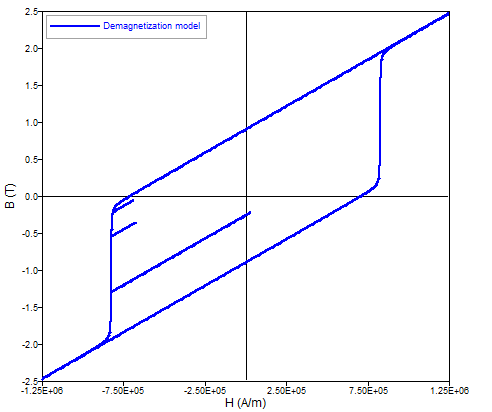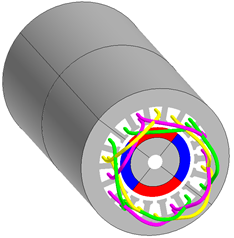Magnet (unidirectional): demagnetization curve (Hc, Br)
Presentation
This model ( Nonlinear magnet described by Hc and the Br module ) defines a nonlinear B(H) dependence with taking into account of demagnetization, wherever the curve knee is.
Main characteristics:
- the mathematical model and the direction of magnetization are dissociated
- a single material for description of several regions
Mathematical model
In the direction of magnetization the model is a combination of a straight line and an arc tangent curve.
The corresponding mathematical formula is written:

with: 
where:
- μ0 is the permeability of vacuum, μ0 = 4 π 10-7 (H/m)
- μrmax is the maximal relative permeability of material
- Br is the remanent flux density (T)
- Js is the saturation magnetization (T)
The shape of the B(H) dependence in the direction of magnetization is given in the opposite figure.
In transversal directions one can write:
B⊥(H)= μ0μr⊥H⊥
where μr⊥ is the transverse relative permeability
Direction of magnetization
The various possibilities provided to the user are the same ones as those presented in § Magnet (unidirectional): linear approximation.
Demagnetization during solving
With this non-linear model, it is now possible to taking in account demagnetization during solving by checking the thick that is provided for. This model is based on a static Preisach model, and can be applied in all over the B(H) law of the magnet:
- Available for 2D and 3D in magnetic transient application
- Initialization by static calculation ()
- This model does not take in account temperature variations

To use this new model with a solved project :
- Destroy results
- Go in and select : Initialization by static calculation
- Create a new material Nonlinear magnet describes by Hc and Br module
- Check the thick Taking in account demagnetization during solving
- Assign the material to regions
- Go to
- Run the scenario
- Create a new isovalues, select magnet and add BrDemag in the formulas field
Example of results

Figure 1. Full device

Figure 2. Br in the magnet
Figure 3. E.M.F with and without demagnetization for
- This new level of modeling can increase the computation time and the memory (ram & disk)
- Not available in 3D with the potential vector and 2D axisymmetric